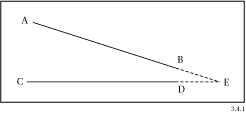TOLERANCE
The TOLERANCE clause must be specified. This value serves as the default tolerance of the input features if the TOLERANCE_ATTR clause is not specified or the features have invalid tolerance value. The minimum value allowed is 0.0.
Si le TOLERANCE_ATTR est spécifié et la valeur de <attribute_name> est plus grande ou égale à 0.0, cette valeur peut être utilisée à la place de la valeur spécifiée dans la clause TOLERANCE.
SIMPLIFY
If the SIMPLIFY clause is set to “YES”, the line weeding / generalization will be included as part of the cleaning process. This involves the removal of line string vertices based on a specified tolerance. This process uses a weeding tolerance of the value of (FILTERFACTOR * TOLERANCE) or (FILTERFACTOR* value of TOLERANCE_ATTR). The latter is used whenever TOLERANCE_ATTR clause is specified and its value is valid. The larger the value of the weeding tolerance, the more vertices will be removed. The default value of FILTERFACTOR is 1.0.

SCHÉMA 1 Ligne avant et après simplification
SHORT_ELEMENT
If the SHORT_ELEMENT clause is set to “YES”, geometries of features that have lengths smaller than the specified tolerances are deleted. Short geometries created during the cleaning process are also deleted.
EXTEND
If the EXTEND clause is set to “YES”, the MRF Extend module is enabled. It is useful to extend certain elements – correcting for undershoot – while maintaining line-work direction. If a feature has a free end, this module will attempt to extend it until it meets other line-work within its tolerance; no intersections are created. This module does not process overshoots; the combination INTERSECTION and DANGLER modules can be used to serve this purpose.
La clause EXTEND développe les éléments de la façon suivante :
- extension ligne-ligne
- extension ligne-arc
- extension arc-arc
Extension ligne-ligne
Dans le schéma ci-dessous, les lignes AB et CD seront prolongées au point E, si E est dans la tolérance d'à la fois AB et CD, et que B et D sont des fins libres.

SCHÉMA 2 Extension linéaire, exemple 1
In Figure 3, lines AB and DE cannot be extended to point F, even though the distance BF is less than the tolerance for AB and EF is less than the tolerance for DE. This is because B is not a free end.

SCHÉMA 3 Extension linéaire, exemple 2
In Figure 4, CD has a tolerance layer larger than both the distances DE and CD. In this case, point D (rather than point C) will be extended to point E, since it has the smaller extension distance.

SCHÉMA 4 Extension linéaire, exemple 3
If a line can be extended to more than one element, it will be extended only as far as the closest one. In Figure 5, line AB will be extended to point C (not D or E).

SCHÉMA 5 Extension linéaire, exemple 4
Extension ligne-arc
Figure 6 shows that circular arc AB will be extended along its path to point C, if BC is less than the tolerance for AB. Also, line DE will be extended to DEF if EF is less than DE’s tolerance.

SCHÉMA 6 Extension ligne-arc, exemple 1
Extension arc-arc
Le schéma 7 montre que pour les arcs AB et DE, si BC est intérieur à la tolérance pour AB, alors l'arc AB sera prolongé en C. L'arc DE sera prolongé en F, si EF est inférieur à la tolérance de DE.

SCHÉMA 7 Extension arc-arc, exemple 1
INTERSECT
MRF Intersect flags and/or creates true and fuzzy intersections. It has element intersection, clustering, and splitting sub-functions.
MRF Intersect reconnaît deux types de relations :
Intersections vraies : quand deux vecteurs se croisent, le point de croisement (X) est appelé une intersection vraie.

Intersections floues : elles sont créées à partir d'éléments qui se trouvent dans les distances de tolérance,
one of the tolerance distances, but do not actually touch or cross. In other words, the two
lignes s'entrecoupent presque, et la distance minimale entre la fin d'une ligne et l'autre ligne
est inférieure aux tolérances des lignes

If the INTERSECT clause is set to “YES”, the MRF Intersect module is enabled. This module computes intersections between all input features, breaking arcs and lines wherever an intersection occurs. A fuzzy intersection is also created from geometries which are within one of the tolerance distances, but do not actually touch or cross.
Si la clause FUZZY_INTERSECT vaut "NON", alors les intersections floues ne seront pas créées dans le processus.
DUPLICATE_REMOVE
If the DUPLICATE_REMOVE clause is set to “YES”, the MRF Duplicate remover module is enabled. Features are considered to be duplicates if their geometries are within tolerance and only features with a smaller tolerance will remain after cleaning.
JOIN
If the JOIN clause is set to “YES”, then singly-connected features will be joined to form longer ones. A pair of linear features become candidates for joining only when the two of them are singly connected at a given node or end point.
CONFLATE
Si la clause CONFLATE vaut "OUI", alors la géométrie d'une entité peut changer pour correspondre à une autre si elles sont presque similaires.
DANGLER
A dangle is a geometry that has at least one free end point. If the DANGLER clause is set to “YES”, MRFCleanFactory will remove dangles if their lengths are less than the (DANGLEFACTOR * TOLERANCE) or (DANGLEFACTOR * value of TOLERANCE_ATTR). Again the latter is always used whenever possible. The default value of DANGLEFACTOR is 1.0.
Voir les topics MRFCleaners pour une description des autres types de clauses de sortie supportées.
FME Community
FME Community iest l'endroit où trouver des démos, des tutoriaux, des articles, des FAQ et bien plus encore. Obtenez des réponses à vos questions, apprenez des autres utilisateurs et suggérez, votez et commentez de nouvelles entités.
Rechercher des exemples et informations à propos de ce Transformer dans FME Community.